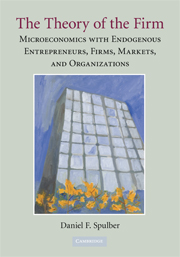 The Theory of the Firm
The Theory of the Firm Book contents
- Frontmatter
- Contents
- Preface and Acknowledgments
- Introduction
- PART I THE THEORY OF THE FIRM
- PART II THE ENTREPRENEUR IN EQUILIBRIUM
- 4 The Entrepreneur
- 5 Competition among Entrepreneurs
- PART III HUMAN CAPITAL, FINANCIAL CAPITAL, AND THE ORGANIZATION OF THE FIRM
- PART IV INTERMEDIATION BY THE FIRM
- PART V MARKET MAKING BY THE FIRM
- 12 Conclusion
- References
- Author Index
- Subject Index
5 - Competition among Entrepreneurs
Published online by Cambridge University Press: 05 June 2012
- Frontmatter
- Contents
- Preface and Acknowledgments
- Introduction
- PART I THE THEORY OF THE FIRM
- PART II THE ENTREPRENEUR IN EQUILIBRIUM
- 4 The Entrepreneur
- 5 Competition among Entrepreneurs
- PART III HUMAN CAPITAL, FINANCIAL CAPITAL, AND THE ORGANIZATION OF THE FIRM
- PART IV INTERMEDIATION BY THE FIRM
- PART V MARKET MAKING BY THE FIRM
- 12 Conclusion
- References
- Author Index
- Subject Index
Summary
Entrepreneurs are the genesis of firms. Through the actions of entrepreneurs, firms obtain their initial missions, goals, business definitions, employees, financing, technology, and organizational structure. The economic theory of the firm must therefore recognize that entrepreneurial decisions endogenously create firms. The purpose of this chapter is to examine the endogenous establishment of firms by entrepreneurs.
The chapter presents a gallery of general equilibrium models with endogenous entrepreneurs. Consumers choose whether to become entrepreneurs and establish firms or whether to become workers. The analysis features competition among entrepreneurs, that is, Type I competition. The analysis demonstrates that important features of entrepreneurship can be analyzed in equilibrium models. In all of the models presented in this chapter, the separation theorem applies, so that firms maximize profit. The analysis further demonstrates that firms can be made endogenous in economic models.
In the first model, entrepreneurs establish firms that offer differentiated products and engage in oligopolistic price competition. The equilibrium number of entrepreneurs depends on differences in the setup costs of establishing a firm. In the second model, consumers solve a two-period consumption-saving problem and entrepreneurs invest in the cost of establishing firms and invest in productive capital. The equilibrium number of entrepreneurs depends on differences in investment costs required to establish a firm. In the third model, entrepreneurs bear the risks that result from uncertain start-up costs. The equilibrium number of entrepreneurs depends on differences in their risks of establishing the firm, with all entrepreneurs having the same risk preferences.
- Type
- Chapter
- Information
- The Theory of the FirmMicroeconomics with Endogenous Entrepreneurs, Firms, Markets, and Organizations, pp. 197 - 228Publisher: Cambridge University PressPrint publication year: 2009


